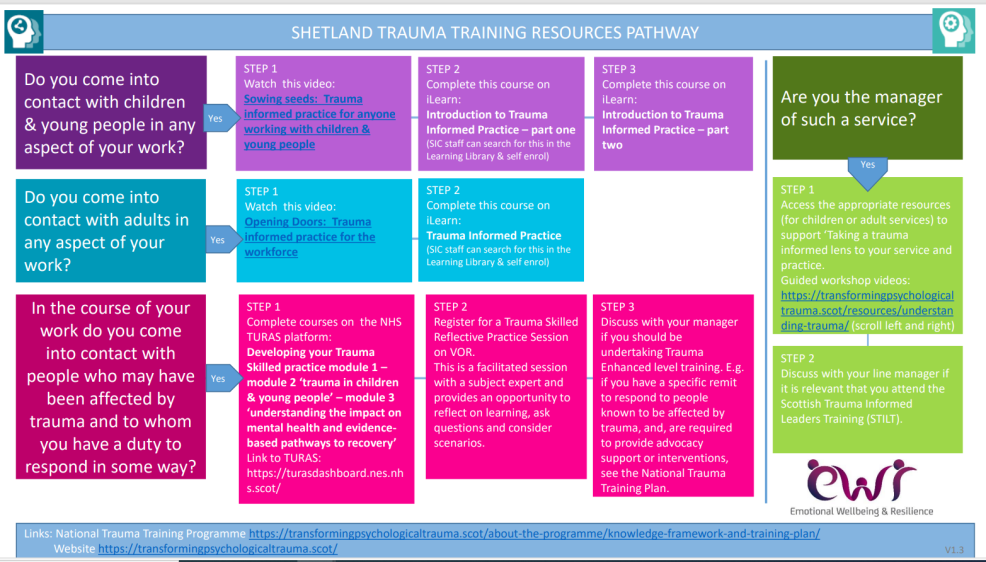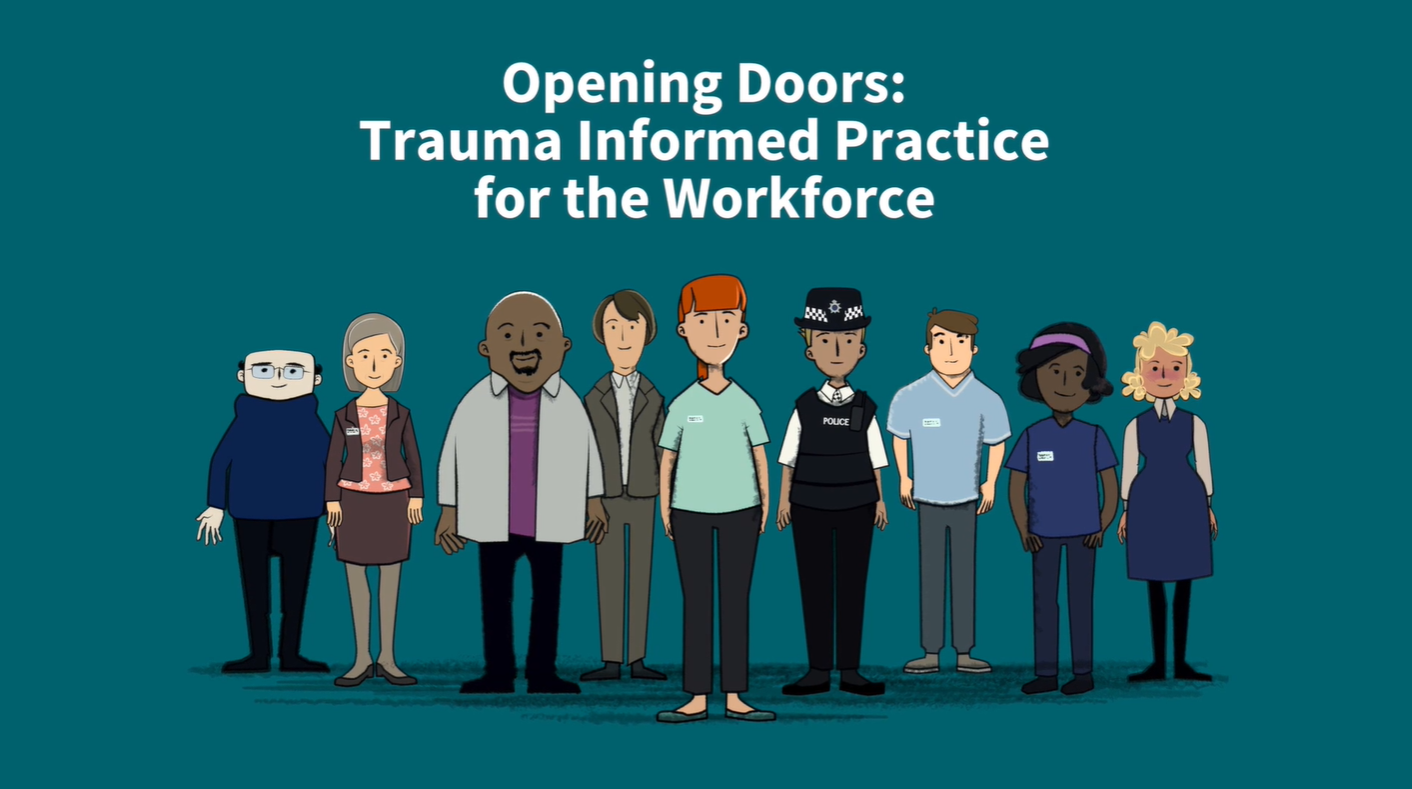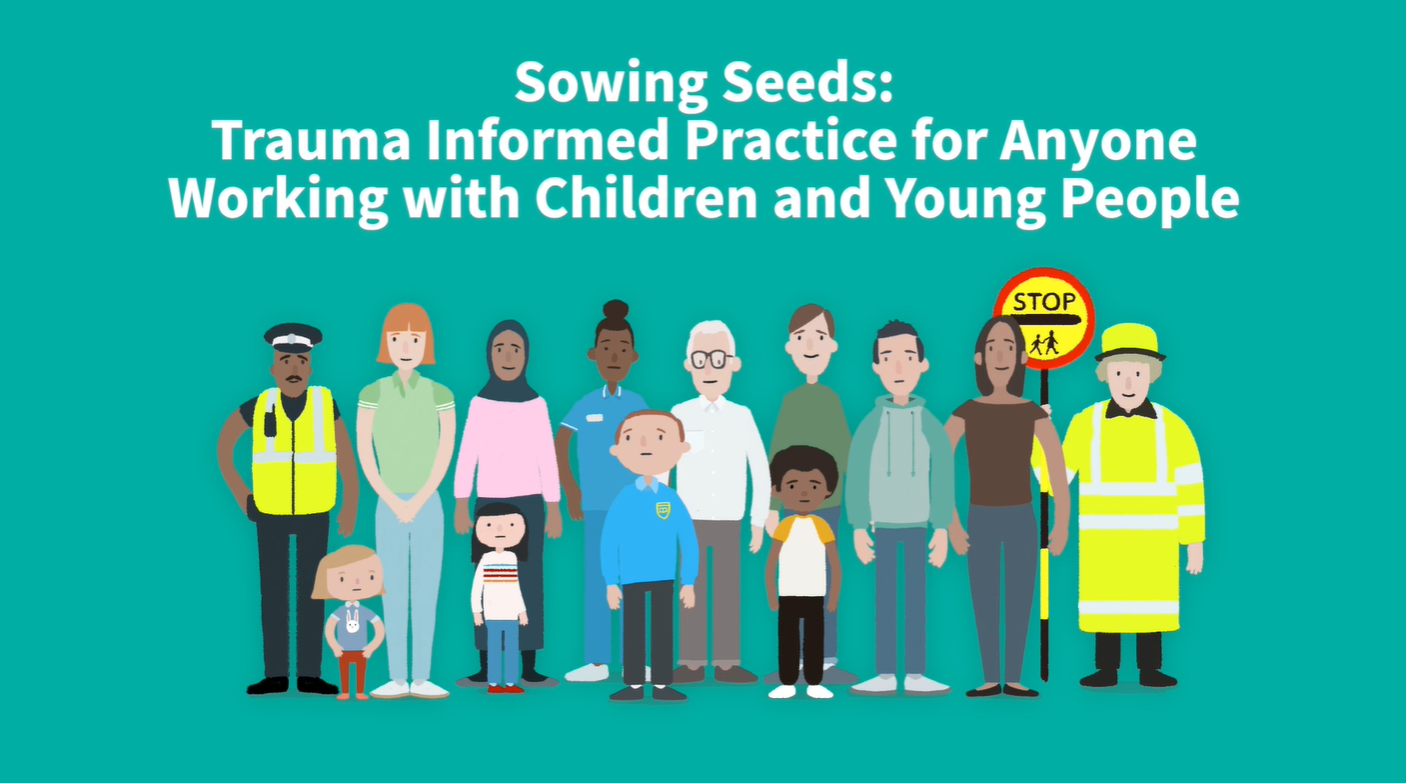This animation explains why and how trauma is everyone’s business. It is designed to support anyone to become trauma informed - no matter what their job or role in society. It covers traumatic events like childhood sexual abuse and domestic abuse, so it is important to look after yourself as you watch it.
All professionals working with children and young people or with their parents or carers must consider the needs of and risks to those children.
- It is everyone’s job to make sure children are safe
The National Guidance on Child Protection in Scotland and Shetland Interagency Child Protection Procedures make it clear that child protection is a shared responsibility. It does not matter if you provide services to adults with childcare responsibilities or directly to children and young people. It does not matter if you are employed by one of the helping agencies or provide invaluable voluntary support, it is everyone’s job to make sure children are safe.
Shetland Interagency Child Protection Procedures ask that everyone follows the 4 R’s:
- Recognise that a child is at risk
- Respond
- Report/refer
- Record
When professionals become aware that a child or young person may be at risk of harm or neglect or if an adults own difficulties are impacting on their ability to provide safe care.
- GIRFEC
Everyone should be aware of Getting It Right For Every Child (GIRFEC) approach in Shetland to the provision of support to children in need who are not at risk. For more information go to GIRFEC
- Training and information
Everyone working with children and adults should have a basic understanding of adult and child protection and training is available for everyone Training | Safer Shetland
Wallet cards are available and a supply can be provided by contacting the Lead Officer.
Basic information about what and how to refer is in the leaflet “What you can do to help if you are worried about a child or young person”.
- Trauma Informed Principles and Practice
The Scottish Government has made a commitment to preventing adverse childhood experiences (ACES) and to supporting the resilience and recovery of all children and adults affected by psychological trauma. This commitment is anchored in the long-standing national approach of Getting It Right for Every Child (GIRFEC) and aligns closely with the incorporation of the UN Convention on the Rights of the Child into Scots law. It also supports the ambition set out in the National Performance Framework of increasing the wellbeing of people living in Scotland and reducing inequalities.
The overarching vision for the National Trauma Training Programme is to develop a trauma informed and responsive nation and workforce, that:
- is informed by people with lived experience
- recognises the importance of wellbeing in the workforce
- recognises where people are affected by trauma and adversity
- responds in ways that prevent further harm
- supports recovery
- and can address inequalities and improve life chances
Trauma is ‘everyone’s business’ and every member of the Scottish Workforce has a role to play in understanding and responding to people affected by trauma. This doesn’t mean that everyone needs to be a trauma expert — we know that different expertise and skills are required to support people’s recovery — but it does mean that all workers, in the context of their own role and work remit, have a unique and essential trauma informed role to play in responding to people who are affected by trauma.
Shetland Islands Council have signed up to the Leadership Pledge of Support (as part of the National Trauma Training programme) to show their ongoing commitment to embedding trauma informed principles and practice and to support anyone affected by psychological trauma.
Those signed up to this pledge agree to:
- Work with others to put trauma-informed and responsive practice in place across our workforce and services.
- Deliver services that wherever possible are actively informed by people with lived experience of trauma.
- Recognise the central importance of relationships that offer collaboration, choice, empowerment, safety and trust as part of a trauma-informed approach.
- Respond in ways that prevent further harm, and that reduce barriers so that people affected by trauma have equal access to the services they need, when they need it, to support their own journey of recovery.
Shetland Islands Council are also funding the Emotional Wellbeing and Resilience project from the ‘Spend to Save’ budget. This is a Shetland Partnership wide project including 3rd sector, Police, NHS Shetland and Shetland Islands Council.
The project vision is:
To give children and young people the relationships and connections they need to build their resilience and emotional wellbeing by bringing services and community together to address the impacts of childhood adversity/trauma.

This animation was developed by NHS Education for Scotland, in partnership with the Scottish Government. It is designed for everyone who works with children and young people. It aims to support people to understand the impact of trauma and to know how to adapt the way they work to make a positive difference to the lives of children and young people affected by trauma
Important Update to clarify the age that young people should be referred to Child or Adult Protection - Protecting Young People
Child and Adult Protection - Protecting Young People
Important information updates for Child and Adult Procedures for all agencies and staff to clarify the age that young people should be referred to Child Protection or Adult Protection if there are concerns that they are at risk of harm.
Please note that this information supersedes the guidance about the age of referral contained in the 2019 Shetland Interagency Child Protection Procedures and should be fully adopted into practice. The 2019 Shetland Interagency Child Protection procedures remain fit for purpose in all other respects and work is underway to update them with the aim of issuing new procedures later this year. (2022)
- For any child or young person up to the age of 18 (regardless of whether they are attending school or not) a child protection referral should be made to Childrens Duty Social Work
- For young people who are over the age of 18, but who are still attending school a child protection referral to Childrens Duty Social Work should be made. For some young people who have additional support needs this may mean that they could be 19 and still attending school, but it would be appropriate to make a child protection referral
- Young people receiving continuing care or through care and after care (i.e. young people up to 26 who have been looked after) Childrens Duty Social Work in the first instance
- For any other young person over the age of 18 for whom there are concerns that they may be at risk then a referral to Adult Duty Social Work under Adult Protection Procedures is appropriate
In any situation where staff are concerned about the safety of a young person it is always appropriate to seek advice from a Line Manger or Duty Social Work – remember its everyone’s job to keep young people safe
It is also important to note that Protocol 11 Vulnerable Young People, in the Shetland Interagency Child Protection Procedures can be used to refer the young person if they meet the criteria contained in the protocol. Web link to Protocol 11 - https://www.safershetland.com/assets/files/cp-procedures-final-march-2019v2.pdf
Following a referral to Duty Social Work an Interagency Referral Discussion may be held involving Social Work, Police Scotland, NHS Shetland and Schools Service (if appropriate). In some cases there may be a joint investigation (police and social work) and in others social work may make a single agency response to the risks and needs of the young person. In all situations, a referral to Duty Social Work is the starting point if a young person is at risk either as a result of their own behaviour or the actions of others.
Childrens Duty Social Work 01595 744420
Adult Duty Social Work 01595 744468
Out of Hours 01595 695611
To make a child protection referral, follow the procedure in the Shetland inter-agency Child Protection Procedures. This provides for a telephone referral followed up with a form sent to Duty social work, which is generally also copied to a central collation point in each agency. Please refer to the Procedures for further details.
If you want to complete the referral form electronically it can be downloaded from this website. Duty Intake Referral Form for Child Protection Referrals The form should be completed and printed off, signed and sent to social work to follow up your telephone referral. Please do NOT e-mail it unless you are sure you have a secure link and have been specifically requested to do so. Even then you should also submit a hard copy, to ensure it receives appropriate management oversight.
Child Protection Training

SPPC runs a range of courses for staff and volunteers working at all levels.
Participants especially value the inter-agency courses - training together aids working together.
Even if you have done child protection training elsewhere, these courses will place your knowledge in the local context and you may bring good practice from elsewhere to share with others. See below for the support and training available and the Training Strategy agreed by all agencies.
Documents
- Its Everyone’s job to keep children, young people and adults safe from harm and abuse. Here is a link to a basic protection training course that is recommended for everyone, but especially for colleagues working in the voluntary sector or with sports and activity groups. The course will help you to recognise abuse, know what to do and where to get help and advice if you need it. You can print out a certificate for doing the course. If your job or voluntary role requires you to complete Level 2 Adult or Child Protection training you need to complete this eLearning first and bring your certificate with you to the half- day training course. Please note staff working for NHS Shetland and Shetland Islands Council should access the e learning through ilearn or Turas https://level1.safershetland.com/
- For All Child and Adult Protection Training please follow this link and search:-
- CPC - Induction - Guidance for Managers
- Sports Coach UK - Safeguarding and Protecting Children - Contact Jack Clubb - 01595 74 4045
For more information on courses please contact SIC Workforce Development Team on Tel: 01595 743920 email: [email protected]
Or contact Sports Development 01595 74 4045.
Links
NSPCC Library & Information Service's CASPAR Email alerts. To sign up to get this info direct, go to https://learning.nspcc.org.uk/newsletter/caspar/.
Support for Individuals – This link is a very specific resource for those who are worried about their own thoughts or feelings towards children. It details support services from a national organisation “Stop it Now” aimed at helping any adult who is experiencing this and it provides some resources that are crucial towards achieving prevention of harm to children.
I have been asked to attend a Child Protection Planning Meeting. What does that involve?
You should attend if you possibly can. Social Workers will prepare a report that include information from all agencies working with the child and family and professionals will be asked to share information with the social worker for inclusion in the report. The information shared still belongs to the agency that shared it and if at all possible staff should ensure that parents attending planning meetings should be made aware of what information is being shared. Careful consideration will have been given to inviting you, but if you think someone else in your organisation would be better placed to provide information, please discuss this with the meeting Chair in good time.
More detailed information about Child Protection Planning Meetings is in Section 10 of the updated May 2019 Shetland inter-agency Child Protection Procedures . You will find pro-formas for reports in Section 13 - Forms and Leaflets. It is important to include the child's own view of their situation as well as your professional view of their best interests.
Further information on your role is in the leaflet: Information for professionals invited to Child Protection Case Conferences [pdf, 56Kb]. You should have received a hard copy of this with your invitation. Please take time to consider it, especially if you have not attended a Child Protection Case Conference very often.
Documents
I have been asked to prepare a report for the Children's Reporter.
I have been asked to attend a Children's Hearing.
What does that involve?
Anyone concerned about a child can tell the Children's Reporter about their concerns, and a Child Protection Case Conference may decide to make a referral to the Children's Reporter. If the Reporter thinks the child may need what are called 'compulsory measures' such as a compulsory supervision order then he/she will arrange a Children's Hearing. You may be asked for information or to prepare a report to help the Reporter decide what to do. If there is no need for compulsory intervention, the Reporter could ask the local authority to provide voluntary advice and assistance.
A Children's Hearing is a legal meeting arranged to consider and make decisions about children and young people who are having problems in their lives. Generally the child or young person and their parents and carers attend, together with a social worker and sometimes other people involved with the child or young person such as a teacher. The Reporter will have asked the social worker for a written report. Three Children's Panel members consider all the information and discuss the case with the people who have been asked to the Hearing. They decide if the child or young person needs legal steps to be taken to help them, and what those should be. The Children's Panel members are trained volunteers. The Children's Reporter attends the Hearing to support fair process.
For more information about Children's Hearings go to: www.scra.gov.uk/home
Child Sexual Exploitation
The Scottish Government has a national plan for tackling CSE and the Digital Safety Committee has responsibility for the local Shetland Plan.
Child sexual exploitation is a form of child sexual abuse in which a person(s), of any age takes advantage of a power imbalance to force or entice a child into engaging in sexual activity in return for something received by the child and/or those perpetrating or facilitating the abuse. As with other forms of child sexual abuse, the presence of perceived consent does not undermine the abusive nature of the act. (Scottish Government Definition 2016)
CSE is a form of sexual abuse and anyone who has concerns that a child or young person is being exploited in such a way should make a child protection referral immediately.
Additional Information
Celcis - Child Sexual Exploitation - guide for health staff
Scottish Government Child sexual abuse and child sexual and criminal exploitation
NSPCC Research and Resources - Child Abuse and CSE - NSPCC Inform
The Upstream Project was set up to enable adults and communities in Scotland prevent child sexual abuse. We believe that preventing child sexual abuse is all our responsibility and this depends on changing the thinking and behaviour of adults. For more information visit -https://www.theupstreamproject.org.uk/ If you would like to know more about Upstream please contact [email protected]
New resources from Upstream can be found at www.stopitnow.org.uk/stop-it-now-scotland/resources)
Services for Professionals – Information for professionals about our services, including case consultation to professionals and how to make a referral.
Disclaimer - On this website we have included links to a number of websites based elsewhere in the UK. They contain a lot of useful information, not all of which is as readily available in Scotland. Although the general advice given is likely to be the same across the UK, websites based in England, Wales and Northern Ireland may refer to the law, institutions and practice guidance in place in those jurisdictions, which are different from those in force in Scotland. For more information about those aspects in Scotland, please refer to Scottish-based organisations, or seek further support locally.


